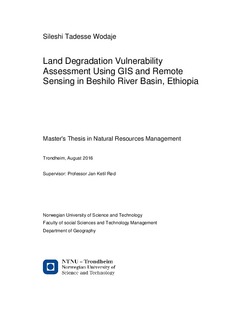Land degradation vulnerability assessment using GIS and remote sensing in Beshilo River Basin, Ethiopia
Master thesis
Permanent lenke
http://hdl.handle.net/11250/2449677Utgivelsesdato
2016Metadata
Vis full innførselSamlinger
- Institutt for geografi [1023]
Sammendrag
Land degradation is a complex environmental problem resulting from various factors. Identification of areas vulnerable to degradation is a first step to develop natural resource management and conservation activities in order to safeguard the environment and the society. This requires a close interaction with the various individual factors, which contributes to degradation. Spatial multicriteria analysis is an important method to deal with such kind of problems. Thus, the objective of this study is to assess land degradation vulnerability in Beshilo basin, Ethiopia, through the integration of GIS, RS and multicriteria analysis. Three groups of land degradation vulnerability indicators, biophysical, chemical, and socioeconomic indicators were identified. More emphasis was given for biophysical and chemical degradation indicators. The biophysical indicators are land use and land cover, soil erosion and vegetation cover. Landsat image for 1986 and 2015 were used to map land use and land cover. The images were classified into five LULC classes such as, agriculture, shrubland, bare land, grassland, and forest using supervised classification. Agricultural land covers a large area followed by shrubland and grassland in both years. Change detection has also been carried out and expansion of agricultural land by 15.3% was the major change observed. Soil adjusted vegetation index (SAVI) has been used to calculate vegetation index and it shows that a large portion of the basin has poor vegetation cover. To model soil erosion, revised universal soil loss equation has been used. The results of RUSLE model reveal that annual soil loss rate is very high in most of the Beshilo basin. The chemical degradation indicators used in the study include organic matter, acidity, salinity, and sodicity. The analysis shows that organic matter is low for 50.4% of the basin. The weights of the indicators were calculated through pairwise comparison and combined using the weighted overlay tool in ArcGIS. The result shows that vulnerability to biophysical land degradation for 61% of the Beshilo basin varies from high to very high. The chemical land degradation vulnerability for 48.76%, 50.87%, and 0.35% of the basin is low, moderate, and high respectively. The combined biophysical, chemical and population density indices show that vulnerability to land degradation is high for 41.4% of Beshilo basin.
